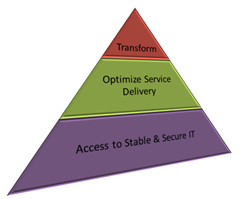Kicking off the 2012 Nonprofit Technology Conference
Looking back for the next generation of nonprofit technology
By Jane Meseck, Director of Citizenship & Public Affairs, Technology for Good
Last month I celebrated my fifteenth year with Microsoft Citizenship. Fifteen years of nonprofit technology craziness, including nine Nonprofit Technology Conferences, two Circuit Rider Round-ups, and over $3 billion of Microsoft software donations to causes around the world supporting everything from puppies to disaster response. I’ve met some amazing and smart people trying to change the world and I’m super proud to be a part of a global community thinking big about how technology can create lasting and powerful social change.
For me, it all started with my first big “I don’t know” moment at Microsoft. I was hired to figure out how Microsoft should support nonprofit use of technology. At the time, I think we were donating about $10M in software each year and had no idea how to respond to all the letters asking for help creating a thing called a website. How could we respond in a way that could have broad impact for the sector not just one nonprofit at a time?
I’d like to think that I was smart enough to say “I don’t know”, and smart enough to find others who were also brave enough to say they also didn’t know, but had a few ideas and a genuine interest in trying to figure it out together. In 1998, these dozen or so nonprofit techies, funders, and interested geeks became The National Strategy for Nonprofit Technology (NSNT). Clearly choosing interesting or sexy code names wasn’t one of our strengths.
NSNT’s goal was simple yet big – to help nonprofits around the world use technology for social change. We set out to better understand nonprofit technology uses and needs, how best to help nonprofits with IT adoption, how we could jointly develop platforms and solutions, and how we could build a movement of people wanting to take forward this goal in a scalable way.
| Some amazing things came from that year of work including a strategy paper that I can’t find in my files. One of my favorite things is the “Pyramid”, a framework for how to think about nonprofit technology adoption and innovation that funders, service providers and IT developers could use to understand how best to support and help nonprofits with technology. |  |
This framework is still relevant today although it has become multi-dimensional and occasionally flips upside down. [Note that the pyramid was originally a 3-tiered cake, yummy but pyramids were easier to draw in PowerPoint than 3-tiered cakes.]
Some of my other favorite ideas and efforts that emerged from this early thinking include NPowerNW, Aspiration, and TechSoup’s online global platform. We also created a common language that supported “appropriate” technology choice and use in the nonprofit sector stressing technology as a strategic tool to support mission.
Part of this work was the creation of the Nonprofit Technology Network (NTEN). NTEN was created as a big tent for people of various backgrounds, platforms and geeky interests to come together to transform technology into social change. A movement that started with 50+ circuit riders (fun term for nonprofit technology service provider) has grown to 15,000 people with more than 1,700 in San Francisco for our annual meet-up this week. Holly Ross and her team should be very proud of the community they have created.
So after 15 years I am having another big “I don’t know” moment. We have come so far, yet I feel something is telling me that we are at another critical inflection point for the sector. I’ve reached out to several of my confidantes and heroes in the nonprofit tech field the past few weeks and consensus is that something is afoot and none of us can articulate exactly what it is.
We are all seeing big changes in technology. Technology is ubiquitous and simpler to use yet the vast number of new developments has created even more complex decisions for nonprofits with little technology capacity. New social media tools, the advent of mobile, big data, and the promise of the cloud bring great opportunities for social change but it also brings additional challenges in how to effectively adopt them. Many nonprofit leaders are still struggling to recognize the need to adopt technology as a mission critical tool to scale and create impact.
There are new players in the nonprofit tech ecosystem: free agents, young innovators, and social entrepreneurs bringing new ideas and solutions. Yet these players are not always connected to the broader sector or platforms that would help to scale their impact.
At the same time, the economy is not being kind to the decade old business models of nonprofit technology service providers. The numbers of funders that directly support nonprofit tech or capacity building services have dwindled dramatically in recent time.
Recognizing this “I don’t know” moment is important and addressing it in an urgent and proactive manner is critical. As we gather in San Francisco this week for this year’s NTC, my challenge to all of us is to create a next generation NSNT, but with a sexier name. We need to hear new and old voices on the challenge of creating the next 15 year roadmap for driving social change through technology.
NTC 2012 be the future!
This year’s Nonprofit Technology Conference takes place this week in San Francisco. If you’re attending do stop by the Microsoft booth and say hello to Jane, Gretchen Deo and James Rooney.
